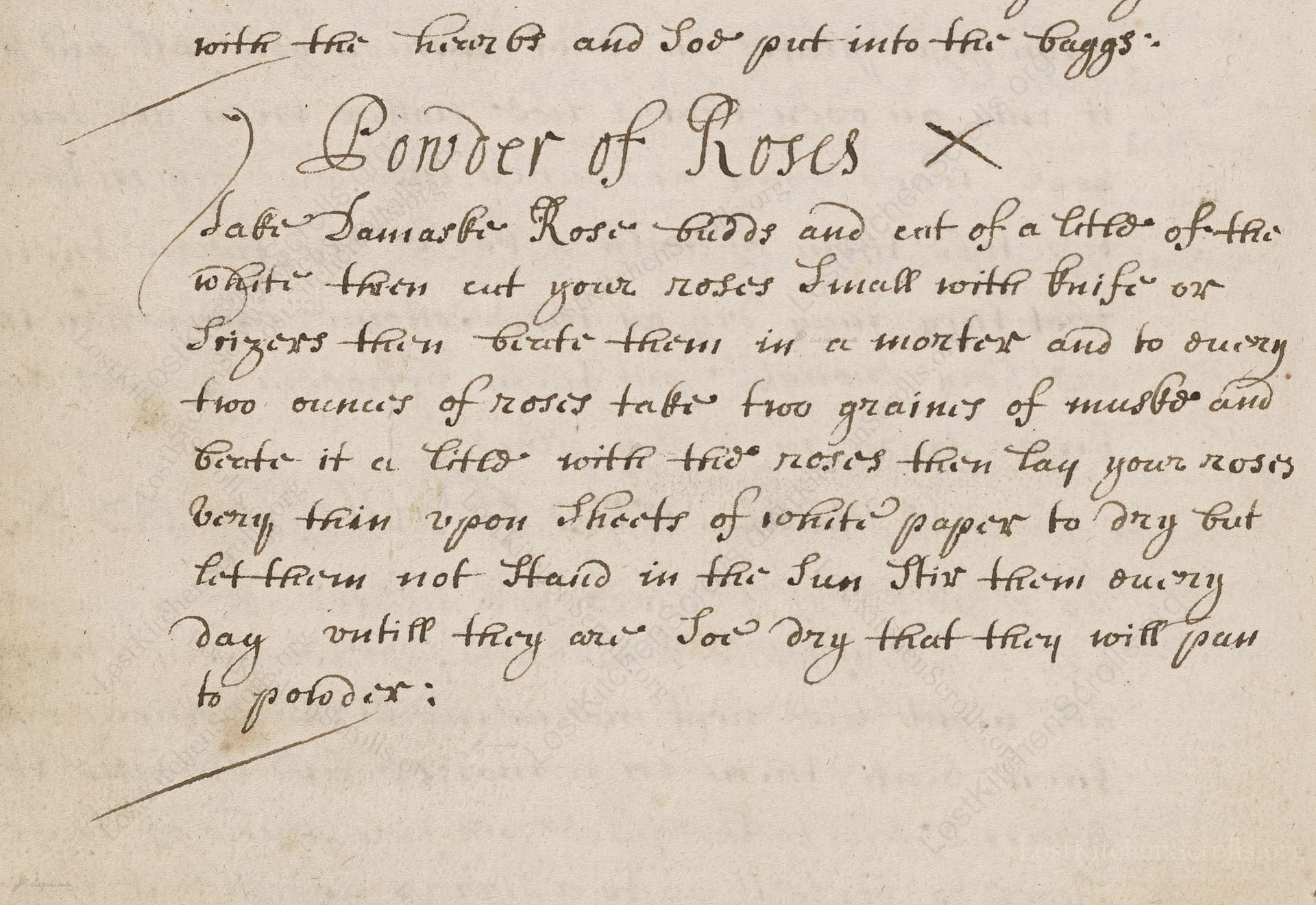To Powder Of Roses
From the treasured pages of Cookery book of Ann Goodenough
Written by Ann Goodenough

To Powder Of Roses
"Take Damaske Rose budds and cut of a litle of the white then cut your roses Small with knife or Scizers then beate them in a morter and to euery two ounces of roses take two graines of musticke and beate it a litle with the roses then lay your roses very thin upon Sheets of white paper to dry but lett them not Stand in the Sun Stirr them ouery day untill they are Soe dry that they will pass to powder:"
Note on the Original Text
The recipe's style reflects 18th-century English household manuscript conventions: straightforward, prescriptive, and reliant on the cook’s judgment for much of the detail. Quantities are given as 'two ounces' for the main ingredient and 'two grains' for the musk, showing use of both weight and apothecary measures common for fine, precious substances. Certain words follow older spellings ('Scizers' for scissors, 'Stirr', 'euery'), and punctuation is sparse, with instructions running together. This conversational, practical tone suggests it was written for a moderately skilled household cook familiar with ingredient handling and preservation techniques.

Title
Cookery book of Ann Goodenough (1738)
You can also click the book image above to peruse the original tome
Writer
Ann Goodenough
Era
1738
Publisher
Unknown
Background
A delightful journey into the kitchens of early 18th-century England, this collection captures the flair and flavors of its time with recipes crafted by the inventive Ann Goodenough. Expect a charming medley of hearty roasts, comforting pies, and time-honored confections, perfect for those wishing to dine as they did in Georgian days.
Kindly made available by
Folger Shakespeare Library
This recipe hails from 18th-century England, dating to the period between 1700 and 1775 and attributed to Ann Goodenough. During this time, rose-based powders were fashionable in both culinary and cosmetic contexts, used to scent confections, sweeten breath, or refresh linens and body. Such recipes often served dual roles as luxurious flavorings and fragrant agents, demonstrating both the medicinal and sensory uses of botanicals in early modern households. Musk, an animal-derived aromatic highly prized at the time, would have added an exotic, opulent note. The use of Damask roses, renowned for their deep perfume, points to the importance of scent and luxury in genteel English domestic life.

In its day, this recipe would require a sharp small knife or a pair of sewing scissors to finely cut the rose petals. A sturdy mortar and pestle—often stone, brass, or wood—was essential for grinding both soft petals and fragrant musk into a combined paste. Drying was accomplished on sheets of plain, coarse white paper, likely linen-based, spread in a cool part of the house away from direct sun to protect the petals' vivid hue and scent. Careful daily stirring by hand ensured even dehydration before the final powdering step.
Prep Time
10 mins
Cook Time
P0D
Servings
4
We've done our best to adapt this historical recipe for modern kitchens, but some details may still need refinement. We warmly welcome feedback from fellow cooks and culinary historians — your insights support the entire community!
Ingredients
- 2 oz fresh Damask rose petals (or best available unsprayed rose petals, white bases trimmed)
- 2 grains musk (or 1-2 drops musk-scented rosewater as a substitute)
- White paper or food-grade parchment (for drying)
Instructions
- To recreate 'Powder of Roses' with modern imperial measurements, begin with 2 ounces of fresh Damask rose petals (about a generous handful), making sure to trim away the very white bases where the petals attach, as these can be bitter.
- Slice the petals finely using a sharp knife or kitchen scissors.
- Place them in a mortar and add 2 grains (about 0.005 ounces) of genuine musk if available, or use 1-2 drops of musk-scented rosewater as a more accessible substitution, and lightly crush together.
- Spread the rose mixture in a thin layer over clean, plain white paper or parchment sheets.
- Allow the petals to air dry in a cool, shaded, well-ventilated spot—avoid direct sunlight, which can fade the color and aroma.
- Stir or turn the petals daily, ensuring all sides dry evenly.
- Once they are fully dry and crumbly, grind the mixture to a fine powder using a clean mortar and pestle.
Estimated Calories
1 per serving
Cooking Estimates
You need about 10 minutes to prepare the petals and mix in the musk. Drying the mixture will take about 2 to 3 days, depending on humidity. This recipe makes enough powder for about 4 small uses or servings, with almost no calories per serving.
As noted above, we have made our best effort to translate and adapt this historical recipe for modern kitchens, taking into account ingredients nowadays, cooking techniques, measurements, and so on. However, historical recipes often contain assumptions that require interpretation.
We'd love for anyone to help improve these adaptations. Community contributions are highly welcome. If you have suggestions, corrections, or cooking tips based on your experience with this recipe, please share them below.
Join the Discussion
Rate This Recipe
Dietary Preference
Main Ingredients
Culinary Technique
Occasions

Den Bockfisch In Einer Fleisch Suppen Zu Kochen
This recipe hails from a German manuscript cookbook compiled in 1696, a time whe...

Die Grieß Nudlen Zumachen
This recipe comes from a rather mysterious manuscript cookbook, penned anonymous...

Ein Boudain
This recipe comes from an anonymous German-language manuscript cookbook from 169...

Ein Gesaltzen Citroni
This recipe, dating from 1696, comes from an extensive anonymous German cookbook...
Browse our complete collection of time-honored recipes



